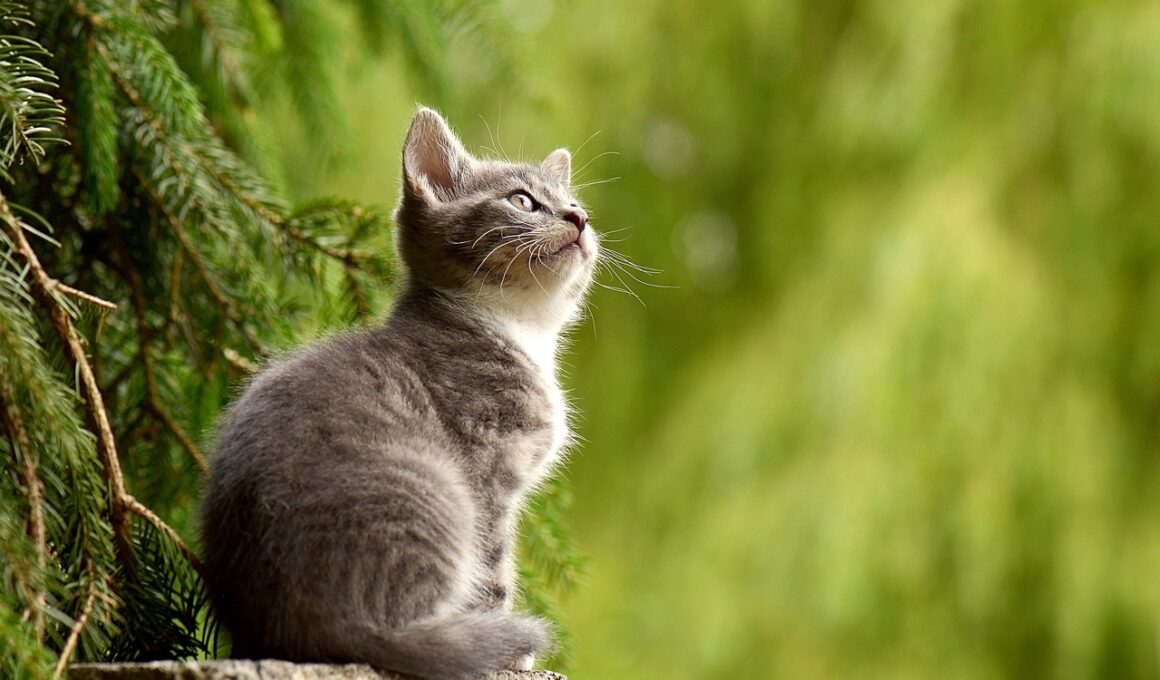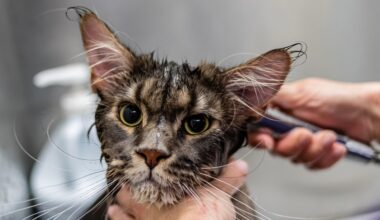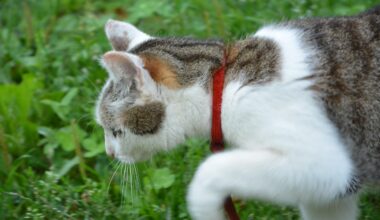How to Safely Socialize Your Kitten with Other Cats
Socializing your kitten with other cats is an essential aspect of their development. A well-socialized cat tends to be happier, more confident, and less fearful. These attributes not only make for an enjoyable pet but can also reduce behavioral issues later on. Start the socialization process early; kittens are especially receptive during the critical period of approximately two to nine weeks of age. Begin by introducing your kitten to other known kittens or friendly adult cats in a controlled environment. Gradual introductions help prevent overwhelming your kitten. Always supervise interactions initially, as this can avert potential aggressive behavior. When introducing them, ensure all cats have a safe space to retreat to. Major components to remember include using scent marks, toys, and short play sessions. During these initial encounters, observe the body language of all cats involved. Look out for signs of stress or aggression and be prepared to separate them if necessary. Patience is key, as some may bond instantly, while others might take time to warm up. By fostering positive experiences, your kitten can grow up to be a well-adjusted adult cat, thriving in the company of others.
Enriching the environment can play a huge role in socializing your kitten. Having multiple territories, like cat trees or shelves, allows cats to explore and observe safely. Cats often appreciate their own space while socializing, which helps them feel less threatened. Incorporate interactive toys to encourage group play, as this can facilitate bonding among cats. Employing treats can also motivate positive interactions; rewarding both your kitten and the resident cats will help them associate with each other positively. For example, you might try giving treats when they are calm and near one another. Regular play sessions and short, controlled interactions can ease tension and enhance relationships. Secure a laid-back adult cat for this process, if possible. An exemplary feline mentor can guide your kitten through proper social behaviors. Cats communicate largely through body language, so teaching kittens to read these signals is crucial. Help them recognize positive signals like purring or slow blinking to promote comfort. Observing as they learn fosters confidence, allowing them to navigate social situations as they grow. The goal is to create positive experiences that lead to nurturing relationships between cats, which benefits their overall disposition.
Monitoring Interaction and Safety
It’s important to maintain a keen eye when allowing your kitten to interact with others. Monitor their interactions closely, especially during the first few meetups. Look for signs of discomfort such as hissing, growling, or flattened ears. These behaviors indicate that a cat may feel threatened. If you notice any of these signs, intervene calmly and separate the cats. Afterward, try reintroducing them gradually. Evaluate their interactions carefully, and allow them to get accustomed to each other’s scents first. This can be done by switching blankets or using a specific rubbing session for both cats. By familiarizing them with one another’s presence without direct confrontation, you can minimize any hostility. The key here is to prevent any negative association or traumatic experiences. Once they exhibit signs of comfort and curiosity, you can gradually increase their interaction time, incorporating positive reinforcement. Additionally, setting fixed times for social sessions can produce consistency and help them adjust slowly. Remember, a comfortable introduction is paramount to forging lasting relationships amongst your pets, leading to cooperative and enjoyable cohabitation.
Age also plays a significant role in how effectively cats socialize. Kittens that are appropriately socialized enjoy lifelong benefits compared to those who aren’t. Kittens tend to be more forgiving and open to new experiences. They also learn better by playing, as their interactions tend to be less rigid than those of older cats. Upon introducing your kitten to older cats, ensure that you approach the introductions with gradual confidence. Establishing hierarchies is natural among felines, so ensuring the dynamics involve plenty of physical space and stimulation is vital. Integrating supervised playtime can help manage any age-related anxiety. Moreover, integrating activities that stimulate both cats physically and mentally can help bridge gaps in communication. Create opportunities for cooperative play with toys that they can chase together. This fosters a positive shared experience. Enriching their environment also plays a part in engagement; cat trees adorned with climbing options introduce playful challenges. Make sure the atmosphere remains stress-free, as this allows them to perceive each other as companions rather than competitors. Your awareness of age dynamics is crucial to cultivate lasting amicable connections.
Using Gradual Techniques for Socialization
Gradually acclimating kittens to older cats requires patience and diligence. Start by allowing them to hear each other first, without direct visual contact. This is simply done by limiting their views while they exchange scents. You can swap places with each cat’s bedding to enable them to familiarize themselves with one another’s scent. Incorporating pheromone diffusers can also create a calming atmosphere. These pheromones, mimicking the natural scents of cats, can help reduce stress or anxiety levels during introductions. When they seem comfortable around one another’s presence, initiate supervised face-to-face interactions. Always start in neutral territory to keep the experience stress-free. This neutral approach allows cats to feel less territorial. Age-appropriate playtime should follow these phased responses, as significant positive associations will be formed. Be alert to positive behaviors like sniffing the other cat or playful pawing. If hostile encounters arise, separate them and give the interactions a break. Try to avoid progress pressure; when the cats feel comfortable, they will interact more freely. This gradual engagement method will enable smoother and more successful socialization between your kitten and other cats.
Fostering social behaviors through various activities is also essential. Engaging your kitten in active play with interactable toys can enhance their confidence. Toys like wands or feather toys encourage movement and stealth, replicating the hunting behaviors they would use in nature. Engaging with the buzz of excitement assists in forging bonds with older or other playful cats; therefore, their shared experience holds more meaning. Create a routine with varied activities that stimulate mental and physical development for your kitten. Methods like clicker training can be instrumental in teaching them how to socialize. The use of clickers and treats reinforce good behaviors, encouraging positive interactions when meeting other cats. Besides toys, also consider introducing simple play games that require teamwork. Shared objectives bridge younger and older cats together efficiently. You can also arrange group enrichment activities that allow kittens to explore while older cats lead. Notably, always ensure there are multiple escape routes and elevated spaces where they can find solace if needed. Gradual, fun activities encourage unique bonds, helping them navigate their social environment positively and effectively throughout their lives.
Long-Term Relationship Strategies
Long-term success relies on continually nurturing bonds between cats throughout their lives. Regular interaction promotes deep connections that flourish over time; it’s essential to maintain those relationships. Consistent monitoring for ongoing positive interactions encourages harmony in your living space. Ensure that each cat understands their routine to mitigate unexpected anxiety. Rotate toys frequently, as this keeps engagement fresh and offers ongoing excitement. Also, establish an effective feeding schedule that minimizes competition during mealtime. Providing sufficient resources is critical, as it helps maintain peace among cats. Quality litter boxes, cozy resting spots, and adequate nutrition will contribute to their satisfaction. Fostering healthy environments through awareness of social cues will lay the foundation for a mutually agreeable atmosphere. Continue introducing new toys or challenges, keeping in mind the individual pace of each cat. Moreover, ensure they have their own space while still gracing the opportunity to socialize. Regular interactions help solidify relationships while minimizing territory disputes. Observing their body language over time enables you to adjust approaches. Ultimately, cultivating a loving home translates into enhanced lives for both you and your companions, promoting peace and happiness for all.
When integrating multiple cats, ensure that you consistently manage behavioral expectations across all interactions. Familiarizing your kitten with boundaries is crucial as they grow up. Creating clear guidelines and establishing a respectful coexistence helps prevent future conflicts. Each cat necessitates its unique approach, emphasizing that one method won’t fit all. Regularly assess the changing dynamics and adapt as needed, encouraging patience and positive instincts. It’s also invaluable to understand that cats often communicate with each other verbally and non-verbally; hence paying attention to these cues helps you better perceive their mood and preferences. Socializing entails flexibility and adaptability; having strategies that can evolve is essential. Remember, the end goal is harmonizing your household with minimized stress levels. Celebrate moments of progress and understand that setbacks may occur. Following these guidelines, you support a diverse range of socialization efforts while they grow comfortably within your loving home. Ultimately, happy cats lead to happy owners. By promoting calm and fulfilling interactions through the tips shared, both you and your cats can enjoy a life filled with laughter and sociability. Your kitten’s transition into adulthood will be smoother, creating valued companions.


